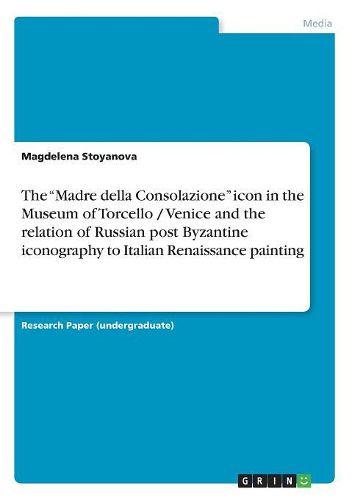Readings Newsletter
Become a Readings Member to make your shopping experience even easier.
Sign in or sign up for free!
You’re not far away from qualifying for FREE standard shipping within Australia
You’ve qualified for FREE standard shipping within Australia
The cart is loading…






Research Paper (undergraduate) from the year 2019 in the subject Art - History of Art, grade: excellent, language: English, abstract: The only mentioning of this Madre della Consolazione icon to the moment belongs to A. Rizzi who attributes it to any anonymous Cretan-Venetian painter of the 16th c. However, many iconographic and stylistic anomalies examined in this study, make such attribution inacceptable. As well inacceptable result some recent publications trying to suggest that the author of this iconographic type should be the Greek icon painter Nikolaos Zafouris and that his devotional paintings destined to Latin clientele should be icons. The objectives of the actual revision of these positions are to contribute for a better distinguishing among originals, copies, and replica of the Madre della Consolazione representations known to the moment, and to complete knowledge of existing sources and data regarding the Orthodox and Italian variants of this Mother of God type as regards religious history, names, iconographic prototypes and sub-variants. The exploration is limited to the microscopic and photographic investigation of the technical-technological aspects of the original. Its guide line is the impact of the post-byzantine painting on other artistic traditions as well as the reverse process, the westernization of the Orthodox painting, and namely: what determined the dynamic of the material & technical upgrading, and if the technical-technological characteristics have any relation to the place of making and to the desired significance of the image; how did traditional egg tempera evolve through mixed techniques to oil painting and how did this influence the plastic construction of the imagery; how was employed the technical knowledge going back to ancient sources.
$9.00 standard shipping within Australia
FREE standard shipping within Australia for orders over $100.00
Express & International shipping calculated at checkout
Research Paper (undergraduate) from the year 2019 in the subject Art - History of Art, grade: excellent, language: English, abstract: The only mentioning of this Madre della Consolazione icon to the moment belongs to A. Rizzi who attributes it to any anonymous Cretan-Venetian painter of the 16th c. However, many iconographic and stylistic anomalies examined in this study, make such attribution inacceptable. As well inacceptable result some recent publications trying to suggest that the author of this iconographic type should be the Greek icon painter Nikolaos Zafouris and that his devotional paintings destined to Latin clientele should be icons. The objectives of the actual revision of these positions are to contribute for a better distinguishing among originals, copies, and replica of the Madre della Consolazione representations known to the moment, and to complete knowledge of existing sources and data regarding the Orthodox and Italian variants of this Mother of God type as regards religious history, names, iconographic prototypes and sub-variants. The exploration is limited to the microscopic and photographic investigation of the technical-technological aspects of the original. Its guide line is the impact of the post-byzantine painting on other artistic traditions as well as the reverse process, the westernization of the Orthodox painting, and namely: what determined the dynamic of the material & technical upgrading, and if the technical-technological characteristics have any relation to the place of making and to the desired significance of the image; how did traditional egg tempera evolve through mixed techniques to oil painting and how did this influence the plastic construction of the imagery; how was employed the technical knowledge going back to ancient sources.